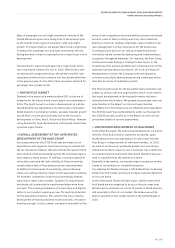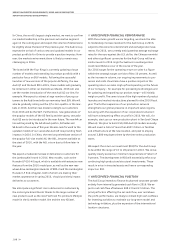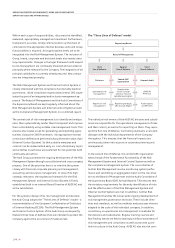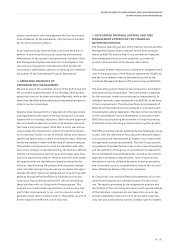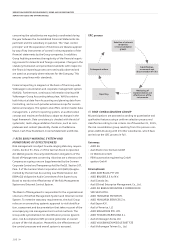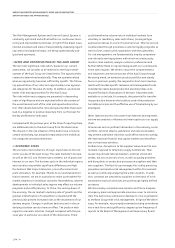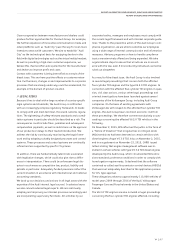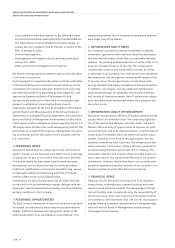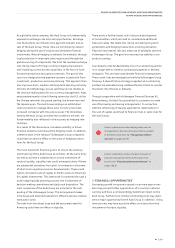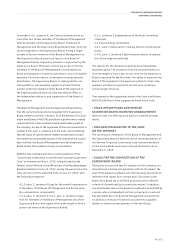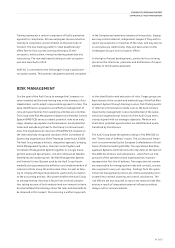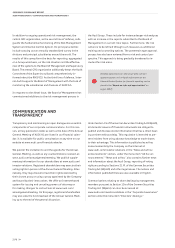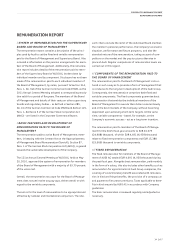Audi 2015 Annual Report Download - page 197
Download and view the complete annual report
Please find page 197 of the 2015 Audi annual report below. You can navigate through the pages in the report by either clicking on the pages listed below, or by using the keyword search tool below to find specific information within the annual report.
REPORT ON EXPECTED DEVELOPMENTS, RISKS AND OPPORTUNITIES
REPORT ON RISKS AND OPPORTUNITIES
>> 197
Closer cooperation between manufacturer and dealers could
produce further opportunities for the Audi Group. For example,
the further expansion of innovative communication media and
retail platforms such as “Audi City” pave the way for even more
intensive contact with customers. We aim to establish “Audi
City” as the technological basis for equipping dealers in the
field with digital technologies such as the virtual reality headset.
As well as providing a high-class customer experience, we
believe this channel offers extra potential for the manufacturer
and dealers to improve profit and costs.
Contact with customers is being intensified as a result of the
diesel issue. This can have positive effects on customer reten-
tion. Furthermore, changes in and improvements to corporate
processes that are already under way could be accelerated, for
example in the domain of product creation.
// LEGAL RISKS
Because it has to deal with a large number of country-specific
legal systems and standards, the Audi Group is confronted
with an increasingly complex regulatory framework. It needs
to comply with and meet technical, fiscal and customs regula-
tions. The tightening of safety-relevant standards and accredi-
tation systems in particular should be described as a risk. The
consequences could include fines, penalties and subsequent
compensation payments, as well as restrictions on the approval
of our products or delays to their market introduction. We
address the risk by continuously monitoring the legal frame-
work and by adopting suitably designed processes and control
systems. These processes and control systems are continually
refined and are supported by specific IT systems.
In addition, there are fundamentally latent risks associated
with legislative changes, which could also give rise to differ-
ences in interpretation. There could be unforeseen legal dis-
putes in such areas as competition law, product liability and
patents in particular. Adequately funded provisions reflect the
current situation in accordance with international and national
accounting standards.
We back up our decisions and actions in all legal areas with the
expertise of the Audi internal legal counsel. In selected cases
we also consult external legal experts. We are continually
adapting and improving our internal processes accordingly and
are incorporating supervisory functions. All activities by our
corporate bodies, managers and employees must comply with
the current legal framework and with internal corporate guide-
lines. Thanks to the preventive action of the Audi Group’s com-
pliance organization, we are able to sensitize our employees
using a wide range of internal communication and information
measures. Advisory programs on how to handle compliance
topics are extensively offered and being expanded. We take
organizational steps to ensure that all actions are in accord-
ance with the law, even if misconduct by individuals cannot be
ruled out altogether.
As a result of the diesel issue, the Audi Group is also involved
in several legal proceedings that concern both the affected
four-cylinder TDI engines and the type V6 3.0 TDI engines. In
connection with the affected four-cylinder TDI engines in ques-
tion, civil class actions, various other legal proceedings and
criminal investigations have been launched against several
companies of the Volkswagen Group, including Audi Group
companies. On the basis of existing agreements with
Volkswagen AG with respect to the affected four-cylinder TDI
engines, the Audi Group bears no direct economic risk from
these proceedings. We therefore comment exclusively on pro-
ceedings concerning the affected V6 3.0 TDI vehicles in the
following.
On November 2, 2015, EPA informed the public in the form of
a “Notice of Violation” that irregularities in nitrogen oxide
(NOx) emissions had been detected on certain vehicles with
diesel engines of type V6 3.0 TDI. Also on November 2, 2015,
and in a supplement on November 25, 2015, CARB issued
letters stating that engine management software was in-
stalled in certain vehicles with type V6 3.0 TDI diesel engines
developed by the Audi Group, which circumvented NOx emis-
sions standards under test conditions in order to comply with
homologation requirements. It declared that the software
contained so-called auxiliary emission control devices (AECDs)
that were not adequately described in the application process
for U.S. type approval.
These allegations relate to approximately 113,000 vehicles of
model years 2009 through 2016 of the Audi, Volkswagen
Passenger Cars and Porsche brands in the United States and
Canada.
The V6 3.0 TDI engines are also included in legal proceedings
concerning the four-cylinder TDI engines affected, including:


